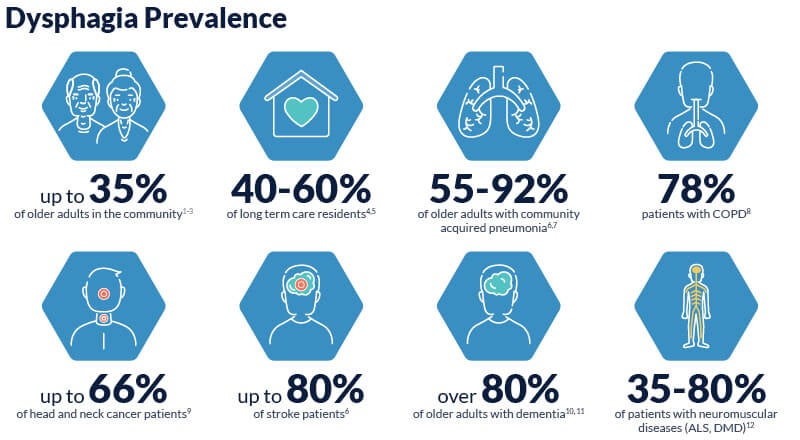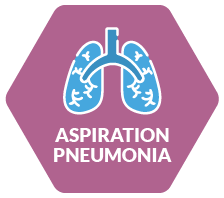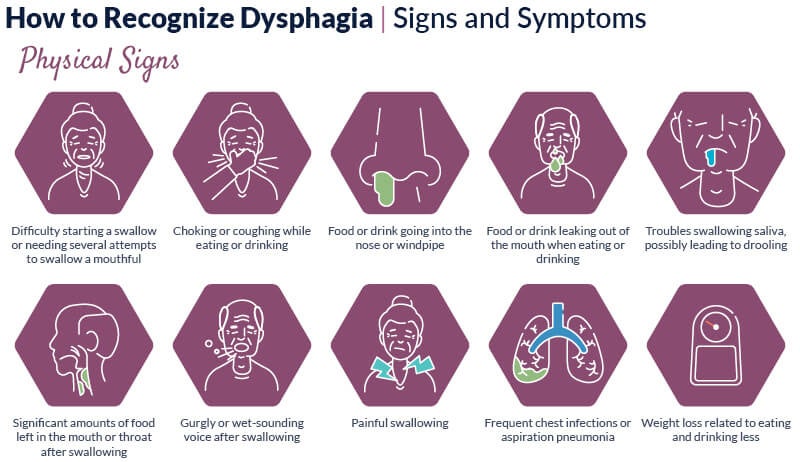What is Dysphagia?
Dysphagia is the medical term for swallowing difficulties. Dysphagia is associated with a wide variety of medical conditions and is commonly under-diagnosed, which can lead to poor health outcomes and decreased quality of life.
What Causes Dysphagia?
Dysphagia is often caused by an illness, condition or disease that affects the nerves and muscles in the tongue, mouth and throat, and leads to problems coordinating and/or controlling the swallow. The list below contains some, but not all, possible causes for dysphagia.
Learn more about Dysphagia

ALS = amyotrophic lateral sclerosis; DMD = Duchenne muscular dystrophy References: 1.Ortega O et al. JAMDA, 2017; 18: 576-582. 2.Serra-Prat M et al. Age Aging, 2012; 41(3): 376-381. 3.Werstuck-MacDonald M Steele C. Can J Diet Pract Res, e-First (open access), April 20, 2021. 4.Carrion S et al. Clin Nutrition, 2017; 36(4):1110-1116. 5.Vucea V et al. J Nutr Health Aging. 2018; 22(8): 916-922. 6.Takizawa C et al. Dysphagia, 2016; 31: 434–441. 7.Cabre M et al. Age and Ageing, 2010; 39: 39–45 8.Lindh M G et al. International Journal of COPD, 2017;12: 331-337. 9.Langmore SE et al. Head Neck, 2016; 38(Suppl 1): E1221–E1231. 10.Michel A et al. JAMDA, 2018; 19: 770-774. 11.Warnecke T et al. Z Gerontol Geriat, 2019; 52: 330–335. 12.Audag N et al. Ther Adv Chronic Dis, 2019; 10: 1–15.





1 Serra-Prat M et al. Age Aging, 2012; 41(3):376-381.
2 Carrion S et al. Clin Nutrition, 2017; 36(4):1110-1116.
3 Cichero J. Regulatory Focus. June 2019. Regulatory Affairs Professionals Society.
4 Clave P et al. Rev Esp Enferm Dig, 2004; 96: 119-131.
5 Ortega O et al. JAMDA, 2017; 18: 576-582.
6 Miller N & Patterson J. Reviews in Clinical Gerontology, 2014; 24: 41-57.
6 Miller N & Patterson J. Reviews in Clinical Gerontology, 2014; 24: 41-57.
7 McGinnis CM et al. Nutrition in Clinical Practice, 2019; 34 (1): 80-95.
How to Recognize Signs and Symptoms
The validated Eating Assessment Tool (EAT-10) is a symptom specific tool to help measure swallowing difficulties. It has 10 questions and can be completed in as little as 2 minutes.
This simple tool can be completed by the patient, a family member/caregiver or together with their healthcare provider.
Access the EAT-10 Eating Assessment Tool
Dysphagia: Understanding & Recognizing Swallowing Difficulties
- In this 12 minute educational video, Registered Dietitian Peter Lam discusses the prevalence, signs and symptoms, and clinical consequences of unmanaged dysphagia. Peter includes an overview of basic swallowing physiology, available screening tools, methods of assessment and current management practices.
Recorded in 2017


